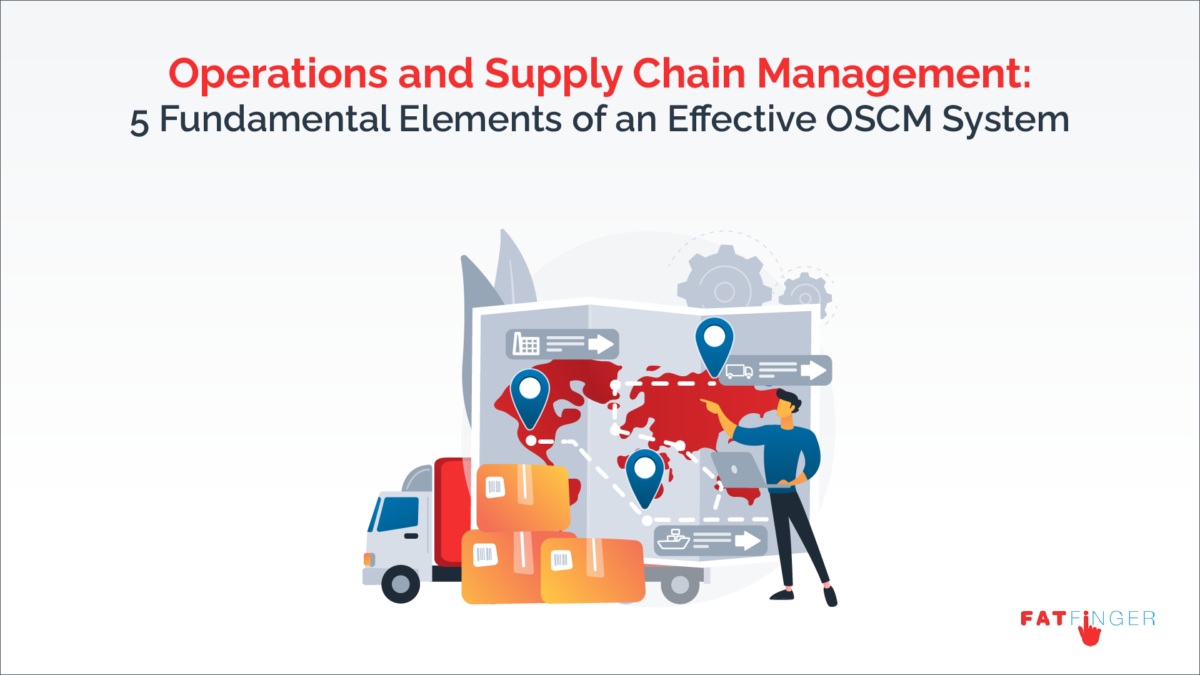The next product you purchase online, take a moment to consider the steps it takes to fulfill your order, and deliver your product to your door. Each step is part of a large network of complex processes. And the management of these processes is termed Operations and Supply Chain Management (OSCM).
OSCM looks at each process involved in transforming raw materials into a final product or service which is then delivered to the consumer. With the overall market for supply chain management expected to reach $37.4 billion by 2027, you can see how the discipline of OSCM is becoming increasingly important.
In this FAT FINGER article, we discuss what operations and supply chain management is, explaining the difference between supply chain management and operations management and how the two are also inextricably linked. We then go on to detail the 5 fundamental elements of an effective OSCM system.
- What is operations and supply chain management?
- The importance of operations and supply chain management
- The 5 fundamental elements of an effective operations and supply chain management system
What is operations and supply chain management?

Both operations management and supply chain management are expected to add value to a business. Both practices oversee, analyze and optimize key business processes with the aim of driving company revenue.
Although operations and supply chain management have a different specific focus, they ultimately pursue similar objectives, inextricably linking the two subjects together. That is, supply chain management is all about effectively delivering a product or service, without which operations management wouldn’t have a product or service to oversee.
Before we consider operations and supply chain management together, let’s consider the function of each separately.
What is operations management?
Operations management is concerned with the conversion of materials and labor to business goods and services with the aim of creating the highest level of efficiency and quality to meet and exceed customer expectations.
To achieve this aim, operation managers need to coordinate internal business processes, maintain these processes, and analyze production systems to identify and remove inefficiencies and errors.
What is supply chain management?
Supply chain management involves the procurement of materials to deliver a given product or service. This demands effective coordination between key players within a given supply chain such as suppliers and logistic teams.
Supply chain management also oversees the purchasing of orders, warehouses, and forecasting. One critical task of supply chain management is to meet current product or service demand and to also forecast demand to avoid oversupply, improve customer service, and coordinate with other business departments (e.g. marketing, sales, finance, and quality assurance teams).
Using operations management and supply chain management together (the key benefits)
As already mentioned, supply chain management deals with the production of a product or service, and operations management then deals with the operations associated with the product or service.
Hence you can see how these functions overlap. Yet, there is one major difference between supply chain and operations management to consider. That is, supply chain management happens outside a company, whereas operations management is concerned with what happens inside the company.
Supply chain managers are hence often dealing with stakeholders external to an organization, negotiating contracts, and evaluating suppliers. The tasks of a supply chain manager are similar across industries.
Operation managers on the other hand deal with internal teams to oversee the daily running of operations and processes. The task of an operations manager will differ substantially across industries depending on the product or service provided by a business.
The importance of operations and supply chain management
No one can argue that having smooth operations is good for business. Repeated dysfunction in a given supply change or within the internal operations of a business will have severe consequences and devastating implications for a business.
To exemplify this, consider the downfall of Sony Betamax videotaping, which was launched in the 1970s. At this time there was strong competition between the Sony system and the Video Home System (VHS) formats, which has since been named the videotape format war.
Sony’s Betamax videotaping system was the first on the scene, yet lost the battle for market share to VHS technology. The reasons essentially boil down to poor operations management. Although Sony was innovative enough to hit the market first, other products became cheaper and better, overtaking the Betamax device. Had Sony applied continuous analysis and improvement of their production systems, then the brand might not have lost the war. This example highlights the importance of supply chain management.

Another example, thinking specifically about supply chain management, is the Yodel 2015 supply chain disaster. Talk about being a victim of your own success. During Christmas, Yodel failed to forecast logistic demands during this busy period and admitted it had stopped collecting parcels from retailers in a struggle to keep up with delivery demands. This failure shows the importance of effective management and planning, to ensure an entire supply chain is prepared for peak volumes in advance, with redundancy built in to meet unexpected fluctuations.
We’ve summarized the main benefits of operations and supply chain management below for your review. Operations and supply management:
- Improves and supports collaboration with key stakeholders (e.g. suppliers, employees, and customers).
- Delivers a system for quality control to consistently give high-quality products and services.
- Reduces overhead costs by identifying operational and supply chain financial risks to then work to mitigate these risks.
- Improves business transparency, providing visible and clear data analytics.
- Creates a more agile and responsive business, giving organizations a competitive edge.
The 5 fundamental elements of an effective operations and supply chain management system
Operations and supply chain management involve monitoring, maintaining, and improving a wide spectrum of internal, and external processes.
Thinking about operations and supply chain management together creates complexity. And smaller businesses could have one person dealing with both, which means things can get a little tricky.
To help you, we’ve detailed the 5 fundamental elements of effective operations and supply chain management systems (as adapted from Trade Gecko).
OSCM element #1: Provide excellent customer service and build positive customer relationships
Organizational success relies on building a strong following of loyal customers. Hence your operations and supply chain management processes should support solid customer relationships with every stakeholder your organization does business with.
In terms of supply chain management, this means you need to be transparent about the supply chain channels you use as these may impact the customer. Your customers need to be able to trust your suppliers and have confidence in your logistic systems. Regularly update your customers regarding the order status.
In terms of operations management, you want to be going above and beyond your customer’s expectations. This means avoiding operational defects to consistently deliver high-quality products. There are many frameworks you can use to identify and remove system defects. One effective method is the PFMEA process. To find out more read PFMEA: Learn How to Remove Error With This 10 Step Guide.
Operation managers also need to think about how they’ll deliver excellent customer service. This means developing a system that effectively delivers relevant operational information to customers, streamlining the delivery of technical information, and avoiding operational issues in the first place.
Supply chain and operational problems that impact your customers often go hand-in-hand. That is, if a technical problem causes a supply chain delay, then that will feed into operations, and cause a delay when the customer receives a product or service.
OSCM element #2: Managing demand to fulfill orders

Demand management is in the hands of the supply chain manager. As already mentioned, supply chain management is about meeting current demand but also forecasting future demand. To do this, you need robust demand planning and inventory optimization processes.
Your aim is to:
- Maintain material and product stock levels, regardless of fluctuations in demand,
- Implement systems to scale up supply chain processes to enter new markets,
- Reduce the need for safety stock,
- Analyze your supply chain processes to make data-informed decisions for demand forecasting, sales, and marketing,
- Effectively manage distribution networks.
Order fulfillment bridges the gap between supply chain and operations management. This is when information regarding incoming orders is communicated properly to supply and operation teams for them to fulfill their duties to the best of their ability. Nowadays, order fulfillment processes occur automatically, especially today in the eCommerce industry where consumers can make orders at a click of a button.
To fulfill orders you need to strategically plan the picking, packing, producing, and fulfillment processes so you don’t overuse your shipping materials or face operational redundancies and obstacles. Or even worse, missing orders in the first place.
Managing orders as they come in successfully comes down to effective cross-functional external and internal, rapid communication. Look to automate these systems, and make sure communications occur across your supply chain and operation teams.
OSCM element #3: Develop positive and supportive supplier relationships
This element refers specifically to your supply chain management processes. Building positive supply chain relationships will directly impact your bottom line by boosting the likelihood of you securing better deals, driving better teamwork between your teams and your suppliers and ultimately creating a streamlined supply chain.
To forge and solidify positive supplier relationships, you need to:
- Maintain open and honest communications: Be honest about your expectations and what you need from your suppliers.
- Communicate your value: Forge a solid agreement that communicates the value your company can bring to your suppliers. This value extends past contractual agreements. Think about how your business can benefit your supplier’s business.
- Be systematic and strategic: Create a systemized approach to how you and your teams engage with your suppliers. Think about what language is used in these communications and document your approach for consistency across the business.
OSCM element #4: Build efficient and smooth operational processes
This element is focused on the operations management side of OSCM. You want your manufacturing operations to be economically profitable. Part of this comes back to effective order fulfillment, and supply chain forecasting. You want to know how much of a product or service needs to be produced in a certain amount of time, to then create just enough so as to not risk wasting inventory, space, and time.
Building efficient and smooth operational processes also means adopting a lean and agile approach, to meet the changing business landscape and customer needs. You want to easily:
- Alter your products or services according to changing customer needs,
- Change your product’s branding, packaging, and unboxing,
- Provide bulk orders of various sizes or discounts,
- Develop additional features for future product or service versions.
So how do you develop lean and agile operational processes?
You use agile and lean methodologies designed to deliver efficient operations. We’ve already mentioned the PFMEA approach to remove system errors, but there are a number of frameworks you can implement to smoothen your operational processes. We’ve detailed a few below, click on the links for more information on each:
- Poka-Yoke What? A Methodology for Quality Assurance to Prevent Costly Errors
- Remove Error From Your Business Operations Using a Pareto Chart (How to Create a Pareto Chart in 10 Steps)
- Create a Lean Business With These 5 Top Process Improvement Methodologies
OSCM element #5: Document your supply chain and operational processes
As already mentioned, your supply chain and operational processes are inextricably linked. Both feed into each other and affect one another. Both demand effective communication between operation and supply chain teams. To drive collaboration you need consistency and transparency. And to achieve consistency and transparency, you need to document your supply chain and operational processes.
Process documentation allows supply chain and operational managers overview what tasks are currently being performed, and the progress a team is making. It also maintains correct process flow so that work is done in the same way every time. Consistency is built in and information is relayed effectively between operations and supply chain teams.
Yet, documenting your business processes can be a massive undertaking, especially if you don’t have a dedicated team to do this. Yet, fear not, as this is what FAT FINGER was created for.
FAT FINGER software makes it easy to document business processes with our no-code documentation software. In addition, you can choose from over 100,000 free templates, to rapidly hit the ground running with tried-and-tested documented processes.
For more information on FAT FINGER and how to get started, watch the below video.
Adopt a holistic and collaborative approach to operations and supply chain management
Operations and supply chain management takes a holistic approach by bringing two disciplines, otherwise thought of as separate, together for improved collaboration. The aim is efficiency and to prepare organizations for future business demands. Although supply chain and operations management have different areas of focus, each feeds into the other. This means efficiency gains in one, boosts the efficiency of the other.
Both systems revolve around the consumer, with the ultimate aim of delivering exceptional customer service by consistently creating high-quality products or services. By following the 5 elements outlined in this article, you have the foundations for building effective operations and supply chain management systems for your business.


